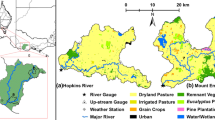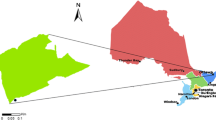Abstract
Very few hydrological models commonly used in watershed management are appropriate for simulating the saturation excess runoff. The Soil Moisture Routing model (SMR) was developed specifically to predict saturation excess runoff from variable source areas, especially for areas where shallow interflow controls saturation. A recent version of SMR was applied to two rural catchments in the Catskill Mountains to evaluate its ability to simulate the hydrology of these systems. Only readily available meteorological, topographical, and landuse information from published literature and governmental agencies was used. Measured and predicted streamflows showed relatively good agreement; the average Nash–Sutcliffe efficiency for the two watersheds were R 2=72% and R 2=63%. Distributed soil moisture contents and the locations of hydrologically sensitive areas were also predicted well.
Similar content being viewed by others
References
J.D. Hewlett and A.R. Hibbert, Factors affecting the response of small watersheds to precipitation in humid regions, in: Forest Hydrology, eds. R.C. Loeher and C.S. Martin (Pergamon Press, Oxford, England, 1967) pp. 275–290.
R.E. Horton, The role of infiltration in the hydrologic cycle, Transactions American Geophysical Union 14 (1933) 446–460.
R.E. Horton, An approach toward a physical interpretation of infiltration capacity, Soil Science Society of America Proceedings 4 (1940) 399–417.
M.T.Walter, V.K. Mehta, P. Gerard-Merchant, A.M. Marrone, J. Boll, T.S. Steenhuis, M.F. Walter and C.A. Scott, A simple estimation of the prevalence of Hortonian Flow in the New York City watersheds, submitted to ASCE J. Hydrol. Engrg. (in press) (2002).
R.A. Young, C.A. Onstad, D.D. Bosch and W.P. Anderson, AGNPS: A nonpoint-source pollution model for evaluating agricultural watersheds, Journal Soil and Water Conservation 44 (1989) n2.
J.G. Arnold, J.R. Williams, A.D. Nicks and N.B. Sammons, SWRRB: A Basin Scale Formulation Model for Soil and Water Resources Management (Texas A&M Univ. Press, College Station, TX, 1990).
M.B. Abbott, J.C. Bathhurst, J.A. Cunge, P.E. O'Connell and J. Rasmussen, An introduction to the European Hydrological System-Systeme Hydrologique European, 'SHE', 1: History and philosophy of a physically-based distributed modeling system, Journal of Hydrology 87 (1986) 45–59.
M.S. Wigmosta, L.W. Vail and D.P. Lettenmaier, A distributed hydrology-vegetation model for complex terrain, Water Resources Research 3 (1994) 1665–1679.
V.P. Singh, Watershed modeling, in: Computer Models of Watershed Hydrolog, ed. V.P. Singh (Water Resources Publications, CO, 1995).
J.R. Frankenberger, E.S. Brooks, M.T. Walter, M.F. Walter and T.S. Steenuis, A GIS based variable source area hydrology model, Hydrological Processes 13 (1999) 805–822.
M.T.Walter and M.F.Walter, The New York City Watershed Agricultural Program (WAP): A model for comprehensive planning for water quality and agricultural economic viability, Water Resources Impact 1(5) (1999) 5–8.
M.T. Walter, M.F. Walter, E.S. Brooks, T.S. Steenhuis, J. Boll and K.R. Weiler, Hydrologically sensitive areas: Variable source area hydrology implications for water quality risk assessment, Journal of Soil and Water Conservation 2 (2000) 277–284.
K.J. Beven and M.J. Kirkby, A physically based variable contributing area model of basin hydrology, Hydrol. Sci. Bull. 24(1) (1979) 43–69.
P.F. Quinn and K.J. Beven, Spatial and temporal predictions of soil moisture dynamics, runoff, variable source areas and evapotranspiration for Plynlimon, Mid-Wales, Hydrological Processes 7 (1993) 425–448.
J.R. Frankenberger, Identification of critical runoff generating areas using a variable source area model, PhD Thesis, Dept. of Agric. and Biol. Engrg., Cornell University, Ithaca, NY (1996).
R.D. Moore and J.C. Thompson, Are water table variations in a shallow forest soil consistent with the TOPMODEL concept?, Water Resources Research 32(3) (1996) 663–669.
T.M. Scanlon, J.P. Raffensperger, G.M. Hornberger and R.B. Clapp, Shallow subsurface storm flow in a forested headwater catchment: Observations and modeling using amodified TOPMODEL,Water Resources Research 36(9) (2000) 2575–2586.
E.S. Brooks, P.A. McDaniel and J. Boll, Hydrological modeling in watersheds of the eastern Palouse: Estimation of subsurface flow contributions, 2000 PNW-ASAE Regional Mtg, ASAE Paper 2000-10, Richland, WA (2000).
M. Franchini and M. Pacciani, Comparative-analysis of several rainfall runoff models, Journal of Hydrology 122(1-4) (1991) 161–219.
T.S. Steenhuis, H.K. Shimbo, W.R. Norman and D.J. Allee, Irrigation potential in the Susquehanna River Basin, Completion Report, Submitted to the Susquehanna River Basin Commission (1986).
J.A. Zollweg, Effective use of geographic information systems for rainfall-runoff modeling, PhD Thesis, Dept. of Agric. and Biol. Engrg., Cornell University, Ithaca, NY (1994).
J.A. Zollweg, W.J. Gburek and T.S. Steenhuis, SmoRMod-A GIS-integrated rainfall-runoff model, Trans. of the ASAE 39(4) (1996) 1299–1307.
J. Boll, C.O. Stockle, S.K. Young, E.S. Brooks, J.E. Hammel, P.A. McDaniel and C.R. Campbell, Progress toward development of a GIS based water quality management tool for small rural watersheds: modification and application of a distributed model, ASAE Annu. Int. Mtg., ASAE paper 982230, Orlando, FL (1998).
W.L. Kuo, T.S. Steenuis, C.E. McCulloch, C.L. Mohler, D.A. Weinstein, S.D. DeGloria and D.P. Swaney, Effect of grid size on runoff and soil moisture for a variable-source-area hydrology model, Water Resources Research 35(11) (1999) 3419–3428.
V.K. Mehta, A GIS-based distributed model applied to two Catskills watersheds, MS Thesis, Dept. of Biol. and Envir. Engrg., Cornell University, Ithaca, NY (2001).
U.S. Army Corps of Engineers, Engineering and design: Runoff from snowmelt, EM 1110-2-1406, Washington, DC (1960).
N. Jarvis and M. Larsson, Modeling macropore flow in soil: field validation and use for management purposes, in: Conceptual Models of V.K. Mehta et al. / Application of SMR to modeling watersheds in the Catskill Mountains 13 Flow and Transport in the Fractured Vadose Zone, eds. E.A.R. Commission on Geosciences (National Academy Press, Washington, DC, 2001) pp. 189–216.
E. Bresler, D. Russo and R.D. Miller, Rapid estimate of unsaturated hydraulic conductivity function, Soil Science Society of America Proceedings 42 (1978) 170–172.
T.S. Steenhuis and W.H. Van der Molen, The Thornthwaithe-Mather procedure as a simple engineering method to predict recharge, Journal of Hydrology 84 (1986) 221–229.
USDA, Soil Survey Manual, USDA-ARS Handbook No. 18 (Washington, DC, 1993).
W. Brutsaert and J.L. Nieber, Regionalized drought flow hydrographs from a mature glaciated plateau, Water Resources Research 13 (1977) 637–643.
W. Brutsaert and J.P. Lopez, Basin-scale geohydrologic drought flow features of riparian aquifers in the southern Great Plains, Water Resources Research 34(2) (1998) 233–240.
N.C. Brady, The Nature and Properties of Soils (MacMillan, NY, 1990).
S.N. Asare, R.P. Rudra, W.T. Dickinson and A. Fenster, Quantification of soil macroporosity and its relationship with soil properties, Canadian Agricultural Engrg. 41(1) (1999) 23–34.
D.R. Maidment, Handbook of Hydrology (McGraw-Hill Inc., NY, 1993).
K.W.Weiler, Determination of the linear bedrock coefficient from historical data, Soil and water Lab. Tech. Rep., Dept. of Agric. and Biol. Engrg. Cornell University, Ithaca, NY (1997).
J. Soren, The groundwater resources of Delaware County, New York, USGS/Water Res. Comm. Bull. GW-50, Albany, NY (1963).
USDA, Soil Survey of Ulster County, New York (Soil Conservation Service, Washington, DC, 1975).
K.A. Smith and C.E. Mullins, eds., Soil and Environmental Analysis, 2nd edn (Marcel Dekker, 2001) p. 637.
J.E. Nash and J.V. Sutcliffe, River flow forecasting through conceptual models, I: A discussion of principles, Journal of Hydrology 10 (1970) 238–250.
M.T. Walter, Winter-time hydrological modeling over a three-dimensional landscape, PhD Thesis, Biosystems Engrg. Dept., Washington State University, Pullman, WA (1995).
J. Martinec and A. Rango, Merits of statistical criteria for the performance of hydrological models, Water Res. Bull. 25(2) (1989) 421–432.
World Meteorological Organization (WMO), Intercomparison of snowmelt runoff, Operational hydrology Rep. no. 23, Geneva, Switzerland (1986).
C. Perrin, C. Michel and V. Andreassian, Does a large number of parameters enhance model performance? Comparative assessment of common catchment model structures on 429 catchments, Journal of Hydrology 242 (2001) 275–301.
A. Guntner, S. Uhlenbrook, J. Seibert and Ch. Leibundgut, Multicriterial validation of TOPMODEL in a mountainous catchment, Hydrological Processes 13 (1999) 1603–1620.
J. Seibert, K.H. Bishop and L. Nyberg, A test of TOPMODEL's ability to predict spatially distributed groundwater levels, Hydrological Processes 11 (1997) 1131–1144.
Author information
Authors and Affiliations
Corresponding author
Rights and permissions
About this article
Cite this article
Mehta, V.K., Walter, M.T., Brooks, E.S. et al. Application of SMR to Modeling Watersheds in the Catskill Mountains. Environmental Modeling & Assessment 9, 77–89 (2004). https://doi.org/10.1023/B:ENMO.0000032096.13649.92
Issue Date:
DOI: https://doi.org/10.1023/B:ENMO.0000032096.13649.92




